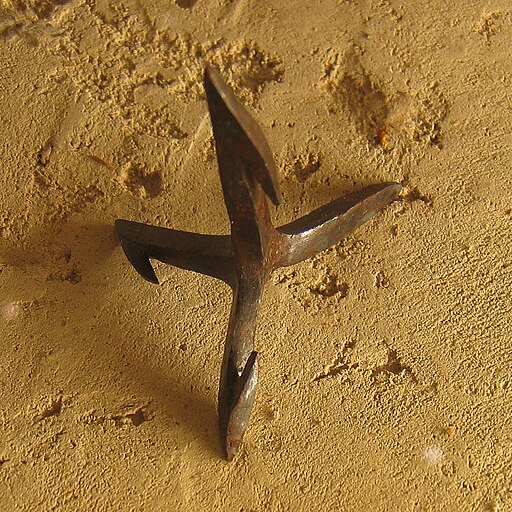A caltrop is a little-known gadget used over the centuries by many armies as an effective and unnerving weapon. Basically, it is made up of two or more sharp nails or metal contraptions arranged in such a way that one of the “legs” always points upward. In antiquity, it was an effective means to slow down enemy soldiers, their horses, and elephants. The upward nails
would injure and impair the infantry soldier who stepped on them. The caltrop
would also seriously hurt the feet of the unshod horses and the sensitive soles
of the elephants’ feet.
It is not known who actually invented the caltrops or even who used them first. Caltrops are hardly mentioned in our historical records. In weaponry, it is clear that our attention goes to the protective outfit of the soldiers and to their apparent weapons like swords and lances and the kind.
The caltrops may have measured about 5 or
The very first recorded use of the caltrop happened in Gaugamela, where the Persians had thrown plenty of so-called crow’s feet on the ground in front of the army. They must have caused Alexander some headaches. Firstly, to discover and locate these weapons, which were often partially hidden or entirely buried; secondly, to avoid them as the troops rushed forward to attack the Persians. In any case, he managed to bypass the trap as he cleared many of these crowfeet and otherwise safely maneuvered around the devices. His infantry, as well as his cavalry, successfully penetrated the enemy lines.
It is still to be determined whether the Greeks were familiar with the caltrops or saw them for the first time on the Battlefield of Gaugamela. Whatever the case, their effectiveness did not go unnoticed, as Alexander’s successors used them repeatedly in their later combats.
At the Battle of Gaza in 312 BC, Ptolemy and Seleucos threw these spiked caltrops in front of their lines to annihilate Demetrios’ elephants. The trick worked perfectly, and after shooting down the mahouts, the elephants were captured by the joint forces of Ptolemy and Seleucos.
A few years earlier, in 318 BC, caltrops or iron spikes were used to stop Polyperchon’s elephants at the siege of Megalopolis. In this case, they were driven in heavy wooden frames connected by chains and thrown in front of the elephants - spikes up. Eventually, Megalopolis did not accept the old general as the new Regent of Macedonia
The Romans, who learned a lot from Macedonian warfare, were also quick to implement de caltrop, although nothing is mentioned about Julius Caesar using them. He probably was the exception, for the Romans used the caltrops effectively in their war against the Parthians in 217 AD and again against the Sassanids in 637 AD.
The caltrop was used throughout the Middle Ages, from Europe to North Africa and Asia - including China

No comments:
Post a Comment